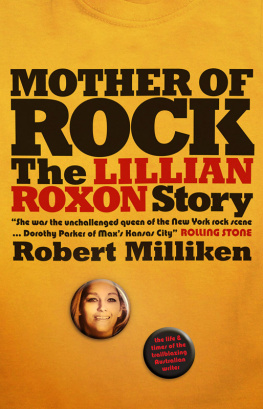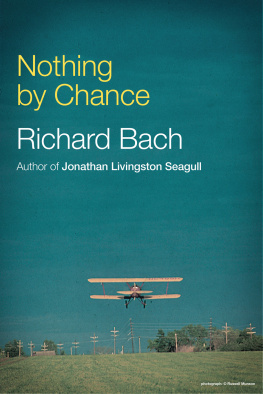Published by Black Inc.
An imprint of Schwartz Media Pty Ltd
37-39 Langridge Street
Collingwood, Victoria 3066, Australia
email:
http://www.blackincbooks.com
First published by Black Inc. in 2002 as Lillian Roxon: Mother of Rock
Revised edition Robert Milliken 2010
All Rights Reserved.
No part of this publication may be reproduced, stored in a retrieval system, or transmitted in any form or by any means electronic, mechanical,photocopying, recording or otherwise without the prior consent of the publishers.
Mother of rock : the Lillian Roxon story / Robert Milliken.
2nd ed.
Includes index.
Bibliography.
Roxon, Lillian. Music journalistsAustraliaBiography. Rock musicHistory.
Other Authors/Contributors: Roxon, Lillian.
E.B. White, Here is New York
Prologue
Lillian Roxon once wrote about Dorothy Parker, the New York writer, wit and journalist: Young, devastatingly attractive, devastatingly witty, she came to epitomise the giddy twenties when life was a laugh, and a well-turned quip was even more admired than a well-turned ankle, though it helped if you could produce both. Substitute the sixties for the twenties and she could have been writing about herself.
She came out of the fifties, one of the wittiest young women Australia produced from that dour decade, to inhabit the New York of the sixties, the decade of the Beatles, the Rolling Stones, Bob Dylan, Vietnam, the Kennedys, sex, drugs and rock and roll, a decade that seemed to be in a state of permanent revolution against the social and cultural rules that hitherto had governed Western societies. Her milieu was the famous round table at Maxs Kansas City, the Manhattan bar and restaurant through which everyone who was anyone in the sixties passed. From that milieu she wrote, in 1969, Lillian Roxons Rock Encyclopedia, the worlds first encyclopedia of rock music and the book that made her a New York celebrity.
Like Dorothy Parker, who presided over another famous round table at the Algonquin Hotel forty years earlier, Lillian Roxon was someone of whom many stories have survived about what she said and what she did. Some of them happened, some of them might have happened. And if they didnt happen, they still found their way into the realm of myth and legend. When Sir Frank Packer, the legendary Australian newspaper tycoon, tried to lure Lillian away from the Sydney MorningHerald, did she really reply that she would require not just a very large salary but the entire senior class of a top Sydney private boys school in a cage?
Craig McGregor, the Australian writer, wrote of her in the New YorkTimes: Like Oscar Wilde, what she writes is but a pale imitation of what she says. Karin Berg, the New York feminist writer, says: Lillian was more loving than Dorothy Parker. She had the wit of Parker but she wasnt so vicious. She was one of the few people I met who would be talking all the time but who you wanted to hear. Mary Cantwell, the managing editor of Mademoiselle magazine in New York, introduced Lillian to her readers as the kind of human being you want to talk with for hours because the talks all a lovely combination of a good brain, a heart and a soul. (Lillians column for Mademoiselle was called The Intelligent Womans Guide to Sex.) Danny Goldberg, the president and chief executive of Mercury Records in New York, says: She had an elevated notion of rock and roll as culture, a notion that was ahead of its time. Germaine Greer, who dedicated her momentous book on feminism, The Female Eunuch, to Lillian, says: I admired her but she disliked me and did not bother to hide it.
I met Lillian Roxon for the first and only time at the end of 1972, when I was a young journalist working in London. She was visiting from New York writing about the British glam rock group Slade, and I went to meet her at the Portobello Hotel, a boutique hotel in Notting Hill favoured by the rock crowd. The triumph of Lillian Roxons RockEncyclopedia, which cemented her status as the unrivalled queen of the New York rock scene, was behind her. So was her feud with Germaine Greer and her friendship with Linda Eastman, the rock photographer with whom Lillian had worked the sixties rock scene in New York, who had married Paul McCartney and simultaneously turned her back on Lillian, her best friend.
Lillian was then forty and at a crucial turning point in her life. Her love affair with rock and roll and the people who made it was undiminished. But asthma had started to ravage her health, the drugs she took to control it had caused her to put on weight, and the glamorous woman I had expected to meet was actually insecure. She started by apologising for the way she looked, even though the facial beauty for which she was renowned, the flawless skin, ravishing smile and sparkling eyes, still shone through.
Then she talked without interruption for the next two hours, entertaining me, shocking me and making me laugh. She told scandalous stories about this one and that one, and even about herself. She also talked about her problems with editors, her asthma and her mother, three principal preoccupations of her life, even though Mrs Roxon, caricatured as an interfering Jewish mother, was long since dead. I remember little of what she said about her, except the line with which she abruptly closed that part of her monologue: Well, now shes up in heaven making Gods life a misery.
A few months after our meeting, Lillian was dead, a victim not of the drugs and the lifestyle that killed so many of those she wrote about but of asthma and its overwhelming impact on her constitution. Yet when I went to New York twenty-five years later, I was amazed to discover how much Lillian Roxon still inhabited the city in the minds of the movers and shakers of rocks golden era. She was being written about as the mother of rock and roll journalism, Americas doyenne of rock critics, the late, beloved rock duchess, and talked about as the worlds first pop journalist, the one who translated sixties culture, art, fashion and music in a popular way ahead even of Tom Wolfe.
The world that Lillian Roxon inhabited is now part of history, the world of the Pink Elephant, the Lincoln Inn and Jamison Street, of Maxs Kansas City and The Scene. And the people who inhabited those places with her are now part of history, too, dispersed into a world of myths and legends that now seems so far away it is often hard to imagine that it ever existed.













